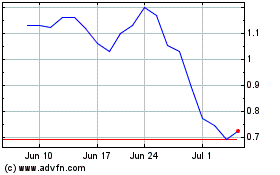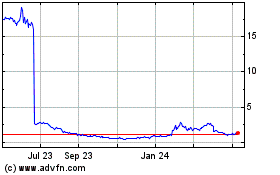FibroGen, Inc. (NASDAQ: FGEN) today reported roxadustat has been
included on the updated National Reimbursement Drug List (NRDL)
released by China’s National Healthcare Security Administration
(NHSA). Roxadustat is included on the NRDL for the treatment of
anemia in chronic kidney disease (CKD), covering patients who are
non-dialysis-dependent (NDD) as well as those who are
dialysis-dependent (DD).
“Inclusion on the NRDL is a significant milestone and inflection
point for the growth trajectory for roxadustat, as reimbursement
provides affordability and access for patients on a national
basis,” said Jim Schoeneck, Interim CEO, FibroGen. “We are grateful
to the NHSA for recognizing the unmet medical need in the treatment
of anemia associated with CKD, and the compelling value proposition
of roxadustat.”
“The timing of inclusion of roxadustat in NRDL is significant in
that it underscores the Chinese government’s commitment to making
innovative medicines accessible on an accelerated basis,” said
Chris Chung, Managing Director, FibroGen China. “FibroGen and
AstraZeneca will work diligently with provincial governments and
hospitals to make this new treatment option available to patients.
Roxadustat was among 97 drugs that were included on the updated
NRDL list through negotiations, the highest number in history.
Implementation will begin at the provincial level, starting January
2020.”
Roxadustat is the first hypoxia-inducible factor prolyl
hydroxylase inhibitor (HIF-PHI) to be approved anywhere in the
world. HIF-PHIs are a brand-new class of drugs developed based on
the groundbreaking science on the body’s oxygen-sensing mechanism
and adaptation to hypoxia which was awarded the 2019 Nobel Prize in
Physiology or Medicine. Results from the two pivotal China
roxadustat Phase 3 clinical trials were published in the New
England Journal of Medicine earlier in 2019.1,2
The dialysis patient population in China, exceeding 600,000
patients, is the largest single-country cohort in the world and is
growing. China also has the largest peritoneal dialysis population
in the world, standing at approximately 14-15% of all dialysis
patients, or 100,000 patients. Roxadustat, with its oral
administration, is particularly well-suited for this population, as
patients receive treatment at home. The addressable anemic
non-dialysis population in China is equally sizable, estimated to
be in excess of 2 million.
FibroGen and AstraZeneca are collaborating on the development
and commercialization of roxadustat in China. Following market
approval, FibroGen China, the Beijing-based subsidiary of FibroGen,
Inc. and the marketing authorization holder of roxadustat in China,
is responsible for commercial manufacturing, medical affairs,
pharmacovigilance, and regulatory affairs. AstraZeneca China is
responsible for promotional activities including marketing, market
access, key accounts and sales.
About Anemia Associated with Chronic Kidney Disease in
ChinaAnemia commonly develops in association with chronic
kidney disease and is linked to significant morbidity and mortality
in both the dialysis and non-dialysis populations. Although chronic
kidney disease (CKD) may occur at any age, it is more common in
aging populations, and its prevalence is increasing. CKD can be
both a cause and a consequence of cardiovascular disease and is a
critical healthcare issue. There is no treatment available that is
curative or can stop kidney deterioration. In China, 120 million
people have chronic kidney disease.3 Anemia is a complication of
chronic kidney disease, is associated with morbidity and
mortality4,5 and remains undertreated in non-dialysis chronic
kidney disease patients worldwide due to delayed nephrology
referral6 and concerns over erythropoiesis stimulating agent
safety.7-9
About RoxadustatRoxadustat (FG-4592) is a
first-in-class, orally administered small molecule HIF-PH inhibitor
that promotes erythropoiesis through increasing endogenous
production of erythropoietin, improving iron regulation, and
overcoming the negative impact of inflammation on hemoglobin
syntheses and red blood cell production by downregulating hepcidin.
Administration of roxadustat has been shown to induce coordinated
erythropoiesis, increasing red blood cell count while maintaining
plasma erythropoietin levels within or near normal physiologic
range in multiple subpopulations of chronic kidney disease (CKD)
patients, including in the presence of inflammation and without a
need for supplemental intravenous iron. Roxadustat is currently
approved in China for the treatment of anemia in CKD patients on
dialysis and patients not on dialysis and approved in Japan for the
treatment of anemia in CKD patients on dialysis. Roxadustat is in
Phase 3 clinical development in the U.S. and Europe and in Phase
2/3 development in China for anemia associated with myelodysplastic
syndromes (MDS), and in a Phase 2 U.S. trial for treatment of
chemotherapy-induced anemia.
Astellas and FibroGen are collaborating on the development and
commercialization of roxadustat for the treatment of anemia in
territories including Japan, Europe, the Commonwealth of
Independent States, the Middle East, and South Africa. AstraZeneca
and FibroGen are collaborating on the development and
commercialization of roxadustat for the treatment of anemia in the
U.S., China, and other markets in the Americas and in Australia/New
Zealand as well as Southeast Asia.
About FibroGenFibroGen, Inc., headquartered in
San Francisco, California, with subsidiary offices in Beijing and
Shanghai, People’s Republic of China, is a leading
biopharmaceutical company discovering and developing a pipeline of
first-in-class therapeutics. The company applies its pioneering
expertise in hypoxia-inducible factor (HIF) and connective tissue
growth factor (CTGF) biology, and clinical development to advance
innovative medicines for the treatment of anemia, fibrotic disease,
and cancer. Roxadustat, the company’s most advanced product, is an
oral small molecule inhibitor of HIF prolyl hydroxylase (HIF-PH)
activity, completing worldwide Phase 3 clinical development for the
treatment of anemia in chronic kidney disease (CKD), is approved by
the National Medical Products Administration (NMPA) in China for
CKD patients on dialysis and not on dialysis and by the Ministry of
Health, Labour and Welfare (MHLW) in Japan for CKD patients on
dialysis. Roxadustat is in Phase 3 clinical development in the U.S.
and Europe and in Phase 2/3 development in China for anemia
associated with myelodysplastic syndromes (MDS), and in a Phase 2
U.S. trial for treatment of chemotherapy-induced anemia.
Pamrevlumab, an anti-CTGF human monoclonal antibody, is in Phase 3
clinical development for the treatment of idiopathic pulmonary
fibrosis (IPF) and pancreatic cancer, and is currently in a Phase 2
trial for Duchenne muscular dystrophy (DMD). FibroGen is also
developing a biosynthetic cornea in China. For more information,
please visit www.fibrogen.com.
Forward-Looking StatementsThis release contains
forward-looking statements regarding our strategy, future plans and
prospects, including statements regarding the development of the
company’s product candidates, the potential safety and efficacy
profile of our product candidates, our clinical, regulatory and
commercial plans, and those of our partners. These forward-looking
statements include, but are not limited to, statements about our
plans, objectives, representations and contentions and are not
historical facts and typically are identified by use of terms such
as “may,” “will”, “should,” “on track,” “could,” “expect,” “plan,”
“anticipate,” “believe,” “estimate,” “predict,” “potential,”
“continue” and similar words, although some forward-looking
statements are expressed differently. Our actual results may differ
materially from those indicated in these forward-looking statements
due to risks and uncertainties related to the continued progress
and timing of our various programs, including the enrollment and
results from ongoing and potential future clinical trials, and
other matters that are described in our Annual Report on Form 10-K
for the fiscal year ended December 31, 2018 and our quarterly
report on 10-Q for the fiscal quarter ended September 30, 2019
filed with the Securities and Exchange Commission (SEC), including
the risk factors set forth therein. Investors are cautioned not to
place undue reliance on these forward-looking statements, which
speak only as of the date of this release, and we undertake no
obligation to update any forward-looking statement in this press
release, except as required by law.
ContactFibroGen, Inc. Michael Tung,
M.D.Investor Relations1.415.978.1433ir@fibrogen.com
- Chen, N, Hao, C, et al. Roxadustat for Anemia in Patients with
Kidney Disease Not Receiving Dialysis. New England Journal of
Medicine 2019; DOI: 10.1056/NEJMoa1813599.
- Chen, N, et al. Roxadustat Treatment for Anemia in Patients
Undergoing Long-Term Dialysis. New England Journal of Medicine
2019; DOI: 10.1056/NEJMoa1901713.
- Zhang L, Wang F, Wang L, et al. Prevalence of chronic kidney
disease in China: a cross-sectional survey. Lancet 2012;
379:815-22.
- Collins AJ, Ma JZ, Xia A, Ebben J. Trends in anemia treatment
with erythropoietin usage and patient outcomes. Am J Kidney Dis
1998; 32: Suppl 4: S133-S141.
- Coresh J, Selvin E, Stevens LA, et al. Prevalence of chronic
kidney disease in the United States. JAMA 2007; 298: 2038-47.
- United States Renal Data System. USRDS 2013 annual data report:
2013 atlas of CKD & ESRD. 2013
(https://www.usrds.org/atlas13.aspx).
- Drüeke TB, Locatelli F, Clyne N, et al. Normalization of
hemoglobin level in patients with chronic kidney disease and
anemia. N Engl J Med 2006; 355: 2071-84.
- Pfeffer MA, Burdmann EA, Chen C-Y, et al. A trial of
darbepoetin alfa in type 2 diabetes and chronic kidney disease. N
Engl J Med 2009; 361: 2019-32.
- Singh AK, Szczech L, Tang KL, et al. Correction of anemia with
epoetin alfa in chronic kidney disease. N Engl J Med 2006; 355:
2085-98.
FibroGen (NASDAQ:FGEN)
Historical Stock Chart
From Mar 2024 to Apr 2024

FibroGen (NASDAQ:FGEN)
Historical Stock Chart
From Apr 2023 to Apr 2024
